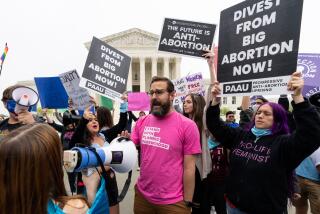Court to Decide if Clinics May Talk About Abortion
- Share via
WASHINGTON — The Supreme Court agreed Tuesday to rule on whether the Bush Administration can prevent health care workers at federally funded family-planning clinics from mentioning abortion to their poor patients.
The case, to be heard in the fall, is a test of the court’s views on free speech as well as abortion. At issue is the medical advice given to about 5 million poor women and teen-agers each year.
Since 1970, Congress has funded family-planning clinics for low-income women but prohibited using federal money to pay for abortions. In February, 1988, the White House went one step further by forbidding clinic employees from discussing abortion or referring patients to abortion clinics.
Challenged in federal court the same day they were issued, the regulations have not yet been put into effect because of the litigation.
The regulations stipulate that clinic workers may not “encourage, promote or advocate abortion as a method of family planning” or distribute written materials on abortion. The rules, according to government lawyers, mean that it would be illegal, for example, to show a pregnant woman a list in the Yellow Pages of doctors who perform abortions.
If a woman visiting a federally funded clinic asks about abortion, workers are supposed to say that the program “does not consider abortion an appropriate method of family planning.” The federal rules add that clinic employees “must” provide a pregnant woman “with information necessary to protect the health of . . . the unborn child.”
Officials of the Ronald Reagan and Bush administrations, in keeping with their anti-abortion policies, have said the government has no duty to promote abortion and may limit how federal money is spent.
Critics of the rules argue that the government should not be allowed to “censor” what a doctor tells a patient. Moreover, they contend, many poor women and teen-agers cannot afford to raise a child and would be given “incomplete and misleading information” about their health care options.
“If a woman came in with an ectopic (or tubular) pregnancy, which can be life threatening, we couldn’t refer her to a hospital for abortion,” said Thomas Kring, executive director of the Los Angeles Regional Family Planning Council.
The federal courts are split on whether the regulations are constitutional. On Tuesday, the Supreme Court in a brief order said that it would hear the case (Rust vs. Sullivan, 89-1391) and resolve the conflict.
The issue in this case is similar to the recent controversy over federal funding for the arts and obscenity. Some First Amendment lawyers say that once the government chooses to fund the arts, it cannot limit the free expression of artists. But others say that the government can set any limits on how its money is spent.
Last year, the U.S. 2nd Circuit Court of Appeals in New York took the latter approach and upheld the abortion-clinic regulations. It said that, while government cannot stop abortion, it can dictate how its money is spent in family planning clinics without violating anyone’s constitutional rights.
“The government has no constitutional obligation to subsidize an activity merely because the activity is constitutionally protected,” the appeals court said.
But a few weeks later, the U.S. 1st Circuit Court of Appeals in Boston struck down the regulations as a violation of a woman’s right to privacy and a doctor’s right to free speech.
The high court’s past rulings give some hope to both sides in this controversy. In the 1973 Roe vs. Wade ruling, the court said the Constitution gave women a right to get an abortion without government interference. It has also ruled, separately, that the First Amendment does not allow government officials to promote an official point of view while stifling differing views.
However, in rulings in 1977 and 1980, the court said the government need not pay for abortion and may “make a value judgment favoring childbirth over abortion.”
A lawyer opposing the regulations said that the family-planning clinics are “health care outposts” in some of the nation’s poorest neighborhoods. They offer advice on contraception or prenatal care and testing for pregnancy, AIDS or venereal diseases as well as routine physical exams.
“For many women, this is their only point of contact with a doctor and the health care system,” said Rachel Pine, an American Civil Liberties Union lawyer in New York, who challenged the regulations on behalf of the Planned Parenthood Federation.
The National Right to Life Committee urged the court to uphold the regulations. “Most Americans do not believe that unborn children should be killed as a method of birth control,” said Douglas Johnson, NRLC legislative director.
Nationwide, 4,500 family-planning clinics are supported by federal spending of $132 million a year. In government jargon, they are known as “Title X” clinics because they are funded under Title X of the Public Health Service Act.
In the Los Angeles area, clinics are located at the county hospitals, at the UCLA Medical Center and in neighborhood health centers, said Kring, who also is president of the National Family Planning and Reproductive Health Assn.
If the Supreme Court were to uphold the federal regulations next year, the California clinics probably would refuse the federal money, he said.
The state provides $32 million a year to the family planning clinics, while the federal government adds $13 million, he said.
Moreover, state law requires doctors to inform patients of their medical options.
“I think we would be in violation of the state law if we withheld information on abortion as an option. So we would be forced to turn down the federal funds,” Kring said.
The court also agreed Tuesday to decide whether the Constitution’s ban on “cruel and unusual punishment” forbids sentencing a Michigan man to life in prison for possessing about 1 1/2 pounds of cocaine.
In the war on drugs, state legislatures and Congress have been imposing ever-tougher sentences for selling or using drugs. In 1988, Congress said that people convicted three times in federal court of selling illegal drugs will be given a mandatory life sentence.
Michigan went even further by setting a mandatory life sentence for possessing a large amount of an illegal drug.
In 1986, Ronald Harmelin was arrested by Oak Park, Mich., police, who found 650 grams of cocaine and a gun in his car. Although Harmelin had no previous record, he was convicted and sentenced to life in state prison. His appeals were dismissed by the state courts.
Last month, while in prison, he filed his own petition with the Supreme Court (Harmelin vs. Michigan, 89-7272).
RESTITUTION RULING--Criminals may file for bankruptcy to avoid restitution. A16
BACKGROUND
The Supreme Court in 1973 ruled that women had a right to an abortion without government interference. But in 1980 the court said the government need not pay for them. In 1988 the White House imposed regulations that prevent workers in federally supported family-planning clinics from mentioning abortions as an option for low-income clients. The regulations were challenged and have not been put into effect. The court agreed Tuesday to rule on the issue that affects 5 million low-income women and teen-agers who visit the clinics each year.
More to Read
Get the L.A. Times Politics newsletter
Deeply reported insights into legislation, politics and policy from Sacramento, Washington and beyond. In your inbox twice per week.
You may occasionally receive promotional content from the Los Angeles Times.











